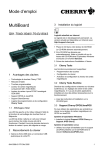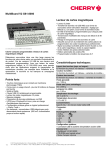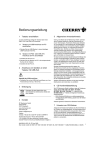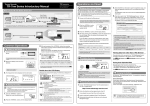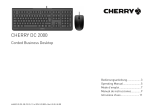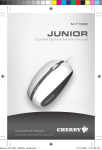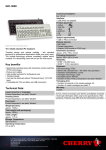Download MultiBoard Operating Instructions
Transcript
Operating Instructions MultiBoard G81-7040/-8040/-7043/-8043 3 Installation of the software Current software on the Internet The software is continually updated. The current version can be obtained on the Internet at: http://support.cherry.de 1 Place the CD in your CD-ROM drive. The CD-ROM starts automatically. 2 If the CD-ROM does not start automatically, double-click the CD-ROM drive in Windows Explorer and then the Start.exe file. 3 Follow the installation instructions on the screen. 3.1 Cherry Tools 1 Advantages of the keyboards • • • • • • • • Cherry FTSC key technology Robust and reliable Programmable keys Magnetic card reader (G81-7040/-8040 only) EMV 2000-approved PC/SC chip card reader OPOS and JavaPOS support Client/server support Cherry Tools software for programming and configuration The following functions are supported: • Programming of keys • Configuration of the keyboard • Activation and configuration of the magnetic card reader 3.2 Cherry Tools Runtime Distributes existing configurations to other systems (e.g. keyboard and magnetic card settings.) No additional applications are installed beside the drivers required for operation. ¾ Read the installation instructions on the accompanying CD-ROM. 3.3 Cherry OPOS/JavaPOS support 1.1 Status indicators If you use applications which access the keyboard or magnetic card reader via OPOS or JavaPOS: The left and center LEDs show the status of the locked-key function of the Num and Caps keys. Windows operating system The right LED illuminates green when the chip card reader is ready for operation. It flickers red while data is being sent from/to the chip card reader. 2 Connection of the keyboard ¾ Install the Cherry OPOS Support or Cherry JPOS Support software. Linux operating system ¾ Use the installation scripts for JavaPOS support on the CD-ROM in the Software\JavaPOS\Linux directory. ¾ Insert the USB plug into any USB port on your PC. 644-0426.00 US Okt 2005 1 3.4 Software for the chip card reader ¾ Install the drivers of the chip card reader for the PC/SC interface (1.0) via the Hardware Assistant. For additional CT-API support (MKT 1.0) and home banking: Using the magnetic card reader 1 Insert magnetic card into the magnetic card reader on the right with the magnetic strip facing downwards and towards the keyboard. 2 Swipe magnetic card through the magnetic card reader to the left. An audible tone confirms a valid reading. (This signal can be deactivated via the software.) The data is transferred. ¾ Run Cherry SmartDevice Setup. 4 Programming of keys and magnetic card reader The configuration of all functions can be done via software macros. This means that the configuration is not saved in the keyboard, but rather as a file on the PC. ¾ Install the Cherry Tools software. You can configure all the functions of the keyboard with the Designer found within the software. Operation is described in the direct help of the Cherry Tools software. It provides you with information where you need it and is called up via F1. 5 Magnetic card reader (G81-7040/8040 only) The functions of the magnetic card reader are available when one of the following Cherry software packages has been installed: • Cherry Tools • Cherry Tools Runtime • Cherry OPOS support • Cherry JavaPOS support for Windows • Cherry JavaPOS support for Linux The magnetic card reader is able to read the tracks individually, in pairs or all at once. Decoding of the read data is carried out via software. Definition of header and terminator: • Header and terminator identify the start and end of the transfer of magnetic card data. The header/terminator code is inserted before/after the actual magnetic card data. 2 6 Chip card reader The integrated chip card reader is available after you have installed the software. It reads and writes to all chip cards conforming to DIN ISO 7816-1/2/3/4. ¾ Insert the chip card into the chip card slot with the chip facing downwards and towards the keyboard. After a discernable pressure point has been passed, contact takes place. 7 RSI syndrome RSI syndrome RSI stands for "Repetitive Strain Injury". RSI arises due to small movements continuously repeated over a long period of time. Typical symptoms are discomfort in the fingers or neck. 1 Set up your workspace for maximum ergonomic benefit. 2 Change the angle of the keyboard using the rear supports. 3 Take several short breaks, with stretching exercises if necessary. 4 Change the position of your body often. 8 Disposal Dispose of the old unit via a collecting point for electronic scrap or via your dealer. 9 Technical data 10 Contact 9.1 Keyboard Cherry GmbH Cherrystraße 91275 Auerbach Germany www.cherry.de/advanced Description Value Interface USB plug Power supply +5 V/DC ±5 % SELV Current consumption max. 300 mA Storage temperature range –20 °C to +60 °C Tel.: +49 (0) 1805 243779 (01805 CHERRY), (0.12 €/min.) E-mail: [email protected] Operating temperature range 0 °C to +50 °C Technical support: Sales: Tel.: +49 (0) 1805 919108 (0.12 €/min.) E-mail: [email protected] 9.2 Magnetic card reader (G81-7040/-8040 only) Description Value Tracks two or three Reading speed 3 to 125 inch/s at 75 bits/inch, 3 to 50 inch/s at 210 bits/ inch Standards ISO 7811/-12, AAMVA, JIS 1 No. of reads up to 1,000,000 9.3 Chip card reader Description Value Transfer rate To the card: max. 420 kbps, To the system: max. 12 mbps Standards ISO 7816, EMV 2000 Level1, CCID, PC/SC, CT-API Protocols T=0, T=1, S=8 (IIC), S=9 (3-wire; SLE 4418/28), S=10 (2-wire; SLE 4432/42) Contacts Landing contacts Insertions/removals approx. 200,000 Please have the following information on hand when contacting technical support: • Item and serial no. of the product • Name and manufacturer of your PC/notebook or motherboard • Operating system and, if applicable, installed service pack version 11 General advice Cherry continuously optimizes products as new technologies are developed. For this reason we reserve the right to make technical alterations. The evaluation of product reliability and the definition of the product’s technical performance are carried out according to Cherry’s own requirements in order to meet internationally recognized regulations and standards. Requirements in addition to these can be met through mutual cooperation. Improper usage, handling, storage and external influences could lead to faults and defects during use. We do not accept warranty for defects caused by alterations to our product by the user and shall not be held liable for unauthorized modifications. All repairs must be made by Cherry or an officially appointed organization or persons. Possible compensation claims against Cherry or its nominated officers – whatever the legal justification including physical or stress related injuries – are excluded. Exceptions to this exist in the case of intent or gross negligence on the part of Cherry, infringements of Product Liability Law or in cases of injury, bodily harm or risk to health. These operating instructions only apply to the accompanying product. Full details can be obtained from your local Cherry dealer or directly from Cherry GmbH. 3 12 Certification 12.1 CE Declaration of Conformity We, Cherry GmbH, hereby declare that the MY 7040 USB and MY 8040 USB keyboards fulfill the following requirements: • Low-Voltage Directive 73/23/EEC tested in accordance with EN 60950 • EMC Directive 89/336/EEC (directive on electromagnetic compatibility), tested in accordance with EN 55022 and EN 55024 Tested according to the standard Cherry testing procedures. 12.2 Information on the GS Approval Due to the position of the zero key on the number block the keyboard is not to be used in Germany for balancing work which is carried out blind to a great extent. A keyboard with non-German key button assignment is not to be used on a long-term basis at computer workplaces in Germany in view of the character assignment (DIN 2137, Part 2). 12.3 Federal Communications Commission (FCC) Radio Frequency Interference Statement Information to the user: This equipment has been tested and found to comply with the limits for Class B digital device, pursuant to Part 15 of the FCC Rules. These limits are designed to provide reasonable protection against harmful interference in a residential installation. This equipment generates, uses and can radiate radio frequency energy and, if not installed and used in accordance with the instructions, may cause harmful interference to radio communications. However, there is no guarantee that interference will not occur in a particular installation. If this equipment does cause harmful interference to radio or television reception, which can be determined by turning the equipment off and on, the user is encouraged to try to correct the interference by one or more of the following measures: • • 4 Reorientate or relocate the receiving antenna. Increase the separation between the equipment and receiver. • • Connect the equipment into an outlet on a circuit different from that to which the receiver is connected. Consult the dealer or an experienced radio/ TV technician for help. Caution: Unauthorized changes or modifications could void the authority to operate the equipment. 12.4 Canadian Radio Interference Regulations Notice of CSA C 108.8 (DOC Jan. 1989) This digital apparatus does not exceed the Class B limits for radio noise emissions from digital apparatus set out in the Radio Interference Regulations of the Canadian Department of Communications. Le présent appareil numérique n’émet pas de bruits radioélectriques dépassant les limites applicables aux appareils numériques de la classe B prescrites dans le Règlement sur le brouillage radioélectrique édicté par le ministère des Communications du Canada. 12.5 VCCI-Statement




